JHP Newsletter - 2011, No. 2, 29 March
Greetings from George, South Africa.
My photo safaris to Tanzania for traditional African plains animals and then to Rwanda for mountain gorillas were a great success, and now Jan and I are enjoying our stay in South Africa.
Equipment: Canon EF 70-200mm f2.8L IS II USM
My new Canon EF 70-200mm f2.8L IS II USM lens was fantastic in Tanzania and Rwanda. In Tanzania, I used it with a Canon Extender EF 2x III to give me an effective 140-400 f5.6 lens to compliment my 500 f4 with 1.4x III, and it was a big improvement over my old Sigma AF 120-300mm f2.8 APO EX IF USM with or without a Canon 1.4x II. The images were much sharper and autofocus was blazingly fast. The autofocus was even better than the 500 f4 with a 1.4x III, so I'm likely going to be an early adopter of the new 500 f4 II to get better autofocus performance. In Rwanda, I used the 70-200 2.8 IS II plain or with a 1.4x III to photograph the mountain gorillas, and I was also quite pleased with the results.
Travel: Tanzania
At the beginning of February, I took some clients to Tanzania for about two weeks to photograph the traditional plains animals in Ngorongoro Crater and Serengeti National Park. The Crater is a great place to start an African safari because it comprises one of the highest concentrations of animals in all of Africa. The safari was timed to coincide with the wildebeest birthing season which provides an opportunity to photograph a birth itself as well as lots of predator-prey interaction. One of the main predators in The Crater is the spotted hyena, and we had several good opportunities to photograph them. One youngster even came up and chewed on our tire and mud flap before he backed away for a portrait (below left). We also watched a single hyena chase down a baby wildebeest. The chase through the herd was exciting to watch, but it occurred too far away to photograph. We also had a good opportunity to photograph a serval, a cat that's about twice the size of a domestic cat. They're not very common to see on safari, so it was great to have the opportunity to photograph one (below right) on our first afternoon in The Crater.
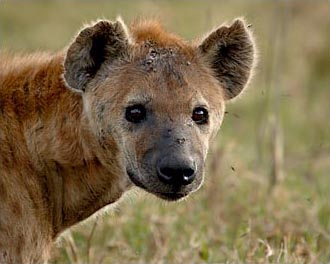
(at 400mm), 1/180 sec, f8, ISO 400
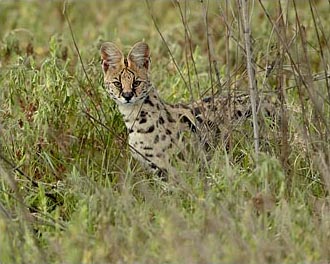
1/350 sec, f8, ISO 400
Another big highlight in The Crater was a very cooperative black rhino. While it's common to see black rhino in The Crater, it's not too common to get good photographs of them because off-road driving is not permitted and most rhinos stay away from the road system. One morning, however, we found a black rhino close enough to the road to get some nice images before she laid down. We waited and had our boxed breakfast while waiting for her to get up and give us an even better opportunity to photograph her, but when she got up she walked away from the road. We left and went looking for other subjects, then returned to where we had left the rhino, and she was back near the road. We photographed her in a much better setting for a while then she came closer and closer to the road and finally crossed the road within 15 yds (13m) of us — spectacular! It was around this point that we started referring to the safari as the "Premium Option Tour" because of the many above-average photographic opportunities.
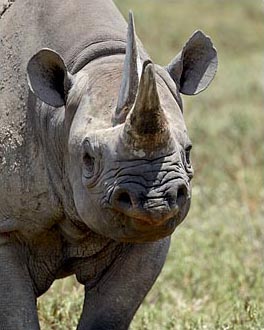
1/500 sec, f8, ISO 400
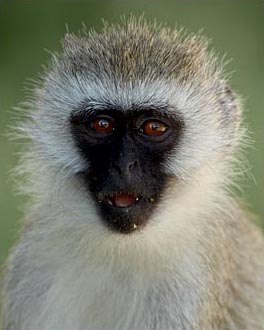
1/180 sec, f8, ISO 400
One of the most entertaining experiences occurred at a picnic area in The Crater. We had stopped for a stretch around noon, and while there we photographed the vervet monkeys that eagerly await the unsuspecting humans to arrive (above right). One such human arrived in another vehicle and the driver/guide told the tourists to eat their boxed lunches in the vehicle. Well, one adventurous gentleman took his boxed lunch out of the vehicle with him and then set it down on the ground so he could use both hands to photograph some of the cute monkeys. The next thing he knew, two of the monkeys had run over, flipped open the lid on his lunch box, and then made off with about half of the food that was inside.
We left Ngorongoro Crater after spending three and a half days in the crater and drove to Serengeti National Park. It's usually not a very interesting drive, but it was extremely interesting this time. I spotted an unusual-looking animal at the far end of a clearing, and asked our driver/guide if it was a jackal because it didn't look quite right. He quickly said it was a caracal! Caracals, also about twice the size of a domestic cat, are very rare to see. So rare in fact, that I had never seen one before on my travels and our driver/guide had only seen six in all of his 11 years as a guide! Unfortunately, it was too far away to photograph, so we just watched it through our binoculars before it disappeared into the brush. Still, it was another sighting on the "Premium Option Tour."
We spent two nights in the central Serengeti then seven nights in the southern Serengeti. The wildebeest migration is in the southern Serengeti in February and March so the females can give birth in the short-grass plains. The short grass provides less cover for the predators and also good forage for the wildebeest. Unfortunately, when we first arrived in the southern Serengeti from Ngorongoro Crater, the migration was not in their usual location because of the lack of rain — the grass was too dry so they had moved elsewhere.
While in the central Serengeti, we spent a morning at the Retima hippo pool. It's one of the best places to photograph hippos because it's possible to get out of your vehicle and photograph from close to water level. There wasn't as much "yawning" as usual, but there were more confrontations than usual. There was also the smallest hippo that I had ever seen, and at one point it climbed out of the water for a while (below right).
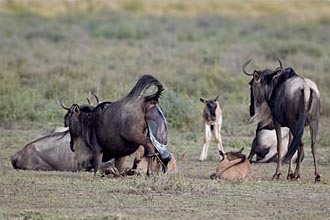
1/350 sec, f8, ISO 400
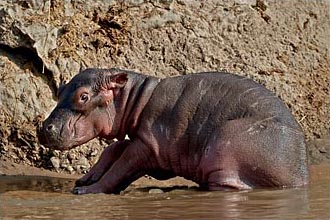
1/350 sec, f8, ISO 400
We had some rain overnight in the central Serengeti and then some afternoon thunderstorms in the southern Serengeti, and that brought the migration back to their usual location to give birth. On our last full day in the Serengeti, we finally saw a wildebeest give birth. We had stopped to photograph some females and babies that had been born earlier that day, and one of my clients said, "That looks odd." I scanned the line of females and quickly understood that he had seen the tips of a baby wildebeest's front legs sticking out from its mother — bingo — a mother giving birth! We followed the mother for about 25 minutes before she dropped the calf. Then we waited another two minutes before the calf tried to stand up and finally mastered that by the time it was four minutes old! It was walking within five minutes and running within eight minutes of being born.
We moved on and came upon a lion cub in a tree. While maneuvering into a good position to photograph it, we spotted a wildebeest kill nearby that the lioness and three cubs had probably finished eating not too long before we arrived. Then I spotted a baby wildebeest wandering towards the lioness and three cubs, probably looking for its mother! The lioness saw it too, and waited for the easy prey to come closer. The lioness had a very short, and easy, chase to capture the wildebeest that had, uh, walked right into the lions' den. Unfortunately, the take-down occurred behind a bush so we couldn't photograph it. The lioness only stunned the wildebeest so that the young cubs could practice killing it, and it was quite sad to watch after witnessing a wildebeest birth less than an hour earlier. But, I think that's the main purpose in life for a wildebeest — to become lion food.
On Valentine's Day, we stopped to photograph a colorful male red-headed agama in a great location, and the next thing we knew a female had come over to join him. It was nice to capture the happy couple cuddling for a while (below left). Elsewhere in the Serengeti, we found a lion pair mating. When lions mate, they copulate about once every 15-30 minutes, and they do that for about 24 hours straight! The pair we watched and photographed (below right) were on a 30 minute cycle, and the third time was a charm, photographically, because they were finally facing the cameras instead of facing away from the cameras.
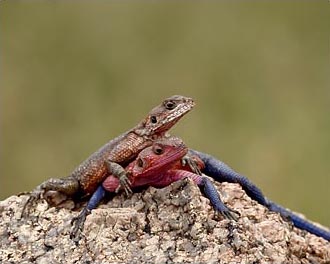
1/350 sec, f11, ISO 400
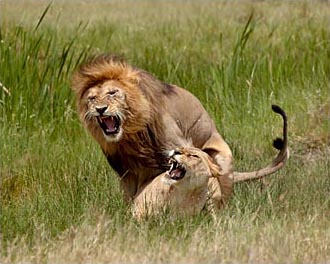
1/1000 sec, f8, ISO 400
Zebras are also part of the wildebeest migration, and I was able to get a nice image of a mother and baby one overcast morning. One of the favorite birds to photograph on safari is the lilac-breasted roller, and we had several that were on good perches in nice light (below center).
One afternoon in the central Serengeti, as we were driving back to camp to beat the approaching thunderstorm, I spotted a caracal by the road! As we were stopping, I spotted a second caracal nearby! Our driver/guide got us into position to photograph each of them, and I was amazed at how laid back they were. We spent about 20 minutes with them, and left only because the light had gotten too low for photography and it had started to rain. I was ecstatic! Before this trip I hadn't even seen a single caracal in the wild, and I had just finished photographing two of them at point-blank range! At that point, the safari was referred to as the "Ultra Premium Option Tour!"
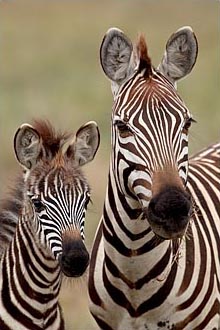
1/500 sec, f8, ISO 500
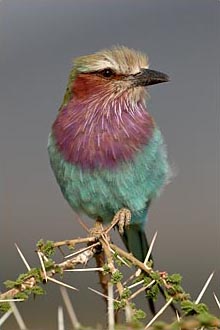
1/1000 sec, f8, ISO 400
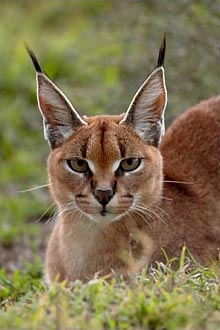
1/90 sec, f5.6, ISO 400
Travel: Gorillas in Rwanda
After the spectacular safari in Tanzania, we flew to Rwanda for five days of gorilla trekking. Mountain gorillas can only be seen in the wild, and Volcanoes National Park in Rwanda is the best place to photograph them. There are eight groups of habituated gorillas for tourists to visit, and one group of tourists per day visits each group of gorillas for one hour. On this trip, all five of our treks were fairly easy. The longest hike was two and a half hours, largely due to other tourists not being prepared for the high elevation hike, and the shortest was a surprisingly short 35 minutes. The weather was generally good for photography with mostly cloudy skys to provide nice diffuse light.
Our last trek was the shortest and provided my favorite image of the trip. We had just started visiting the Umubano Group when Charles, the silverback, walked by us to join the rest of the gorillas. He paused in an area with low vegetation and posed nicely (below left). Two infants and three juveniles played amongst each other almost the whole time we were with them — the most activity I've ever experienced on a gorilla trek.
We photographed the Amahoro Group almost exactly where we photographed them in 2005! It wasn't a particularly good location because of the steep slope with thick moist vegetation covering downed logs, but at least there wasn't an overhead canopy to provide mixed shadows on that day with only a thin layer of clouds. My favorite image of that trek is of a blackback, an adult male whose back hasn't started to turn silver, resting behind some thick vegetation. His engaging eye contact makes you wonder what the gorillas think of the human visitors. He was resting in a small area of full shade, so there were no harsh shadows to contend with.
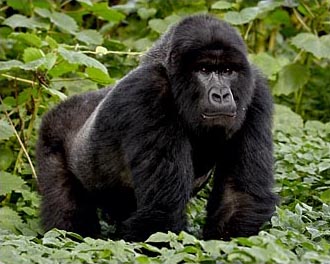
of the Umubano Group
1/90 sec, f4.5, ISO 640
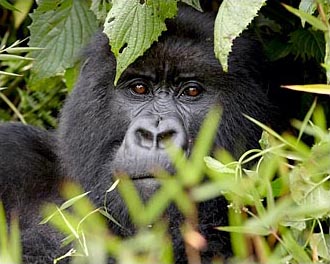
of the Amahoro Group
1/180 sec, f6.7, ISO 400
The Hirwa Group had a 15 day old infant and 20 day old twins. Twins among mountain gorillas is rare, and it was a real treat to see and photograph them. However, my favorite image from the Hirwa Group is of the mother holding her 15 day old infant (below left). She looks almost human in her behavior.
One infant in the Kwitonda Group enjoyed climbing on a vine while his mother rested below, and he gave us many opportunities to photograph him (below center).
The Sabinyo Group has the largest silverback mountain gorilla in the world. Guhonda weighs about 220kg (485 lbs) and most silverbacks are about 200kg (440 lbs). Before we left the group, he sat up and posed (below right) before leading the group away — it's almost like he had a watch and knew when our hour was up.
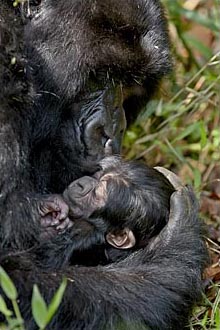
of the Hirwa Group
70-200 2.8 IS II & 1.4x III
(at 280mm),
1/125 sec, f5.6, ISO 500
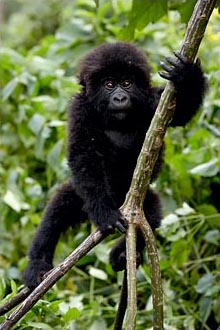
of the Kwitonda Group
(at 125mm),
1/180 sec, f6.7, ISO 400
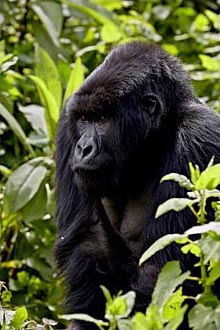
(at 200mm),
1/250 sec, f5.6, ISO 400
I met up with Jan in the Johannesburg airport after I flew in from Nairobi and she flew in non-stop from Atlanta. We've had a great time so far in South Africa, and I'll tell you about that when we return to the States.
Take care and happy shooting.
— James
James Hager Photography :: www.jameshagerphoto.com




